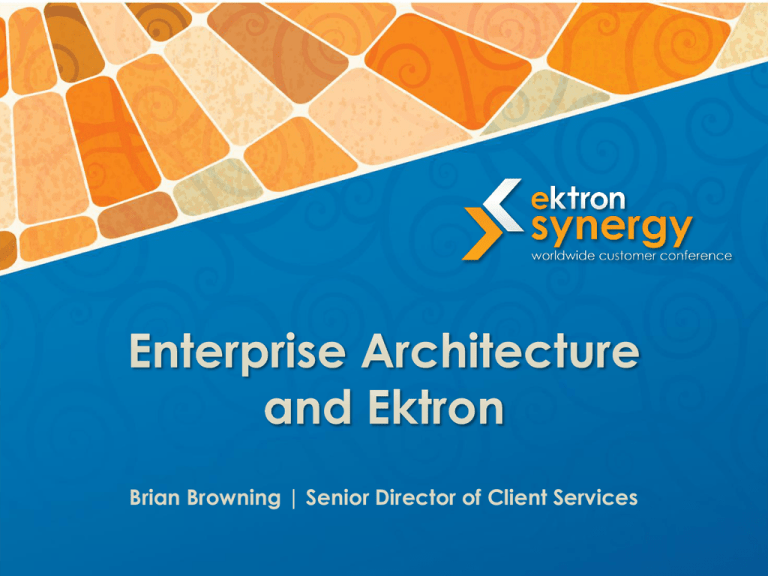Hosting Infrastructure for the Enterprise
advertisement

Brian Browning | Senior Director of Client Services • Examples of Successful Enterprise Sites on Ektron • Hosting Infrastructure for the Enterprise – Hosting Models • Tiered Models • Role of e-Sync • Geographically Dispersed Hosting – Tips for Scaling and Performance – Strategy for Deployment • • • • Requirements Gathering Infrastructure Planning Implementation Testing • Integration – Core Ektron Application Architecture – System of Record Definitions – Ektron APIs • Question / Answer Session AMC Theaters uses Ektron to handle the traffic of 75,099,651 page views per month www.amcentertainment.com Citigroup uses Ektron to handle the traffic of 44,357,941 page views per month www.citicards.com Walmart uses Ektron to handle the traffic of 17,256,067 page views per month http://instoresnow.walmart.com Mitsubishi supports 112 corporate and dealer sites www.mitsubishi-motors-europe.com Saint-Gobain supports their multiple international businesses with 88 sites www.saint-gobain.com Rice University supports 50 school sites www.rice.edu • Hosting Models – Single Server • Virtual Stage / Production – 2 Tier • Development / Production – 3 Tier • Development / Staging / Production – Hybrid Models • Ektron’s Architecture is Flexible enough to cover almost any hybrid model • 4 Tier, 5 Tier, 6+ Tiers – Multiple Site Models • Authoring Environment Definition – Flexibility abounds when it comes to deciding where to author content in the Enterprise – Display Servers versus Authoring Servers – Most Enterprise Customers choose to author within a Staging or Authoringspecific environment before pushing to Production • A Closer Look at e-Sync – e-Sync migrates: • Content stored in the SQL Server database • File system assets (ASPX Templates, Search Indexes, Uploaded Assets, DMS) – Each can be moved independently based on custom e-Sync Profiles – e-Sync can be configured to push content and related assets: • Automatically • On a Scheduled Basis – e-Sync is also Bi-Directional, so authoring can occur in multiple environments and be synchronized throughout the entire hosting environment – Multiple databases can be used to improve performance or to handle multi-site configurations • Tips for Scaling and Performance – Importance of Caching • Control Level • Page Level • Server Level – Content Delivery Networks • Offload bandwidth intensive content to CDNs to improve performance – Streaming Media, Large File System Assets • CDNs also deliver content based on geographical location and can dramatically improve perceived performance • Requirements Gathering – Current Activity Analysis • Based on current site traffic reviews – Estimation of Production Load Levels • Get Business Stakeholder Buy-In – Fail-Over / Redundancy Planning • Hot Environment • Cold Environment – Ektron Licensing Compliance • Infrastructure Planning – Procurement / Critical Path Identification – Associated Hardware • Load Balancing Hardware • Any Associated Switches, Routers, etc. – Software Needed • ETL • Migration Tools • Performance Monitoring – Development of Custom e-Sync Plan • Implementation – Build-out of Environments – Implementation of e-Sync throughout – Testing • Security Scanners (Acunetix) • Performance Testing Tools (LoadRunner) • Testing – Performance and Load Testing – Review Architecture of the Source Code • Define Performance Standards for Source Code as part of the Discovery Phase • Focus On: – Reducing calls to the web server – Simplifying Javascript and CSS – Leveraging Caching • Continuously monitor over time • Anticipate periods of Peak Performance – Driven by Marketing or Business Needs • Integration – System of Record Definitions • Importance for Data Integrity – ETL Approaches • Extract Data from Source System • Transform to Match Ektron’s Table Structure • Load into Ektron – Be careful about Customizing Ektron DB Structure • Avoid Problems with Future Upgrades • Leverage Ektron API at all times! • APIs are the heart of integration with Ektron • APIs protect custom functionality in the event of future upgrades • Ektron APIs Include: – Ektron.cms. framework – Ektron.cms.API • Ektron Application Layer • Ektron Data Access Layer • Provider Models – – – – Analytics Personalization Membership Mapping • Extensions • Integration with Third-Party Systems and Applications – Integration is often the most complex part of an Enterprise Ektron build – Integration typically drives the most business value – Each implementation of a third-party system or tool is unique Thanks for attending today! For more information, please contact: Brian Browning Senior Director of Client Services brian.browning@ektron.com 804-441-6139






